There are 22 species of turtles in North Carolina and that can be seen from the many beaches. Seventeen are freshwater turtles and 5 are endangered sea turtles. Here we will go over them all. You can use this list as a herping guide while hiking the mountains, boating the many lakes and rivers, or if you’re thinking of owning one as a pet.
Many of North Carolina’s native turtles are protected by legal barriers, so check the laws before purchasing a pet turtle. We also implore you not to take wild turtles as pets.
Wild turtles placed into captivity, no matter how elaborate the setup, don’t do well as pets. They become incredibly stressed, and their lives are drastically shortened. They can also become severely ill.
If you’re looking for a pet, there are plenty that can be adopted, or you can find licensed breeders that can sell you a captive bred turtle that is used to human interaction and will live a long, happy, healthy life with you.
Now, let’s find out what turtles you may come across in the Tarheel State.
Table of Contents
Turtles in North Carolina
1. Bog Turtle
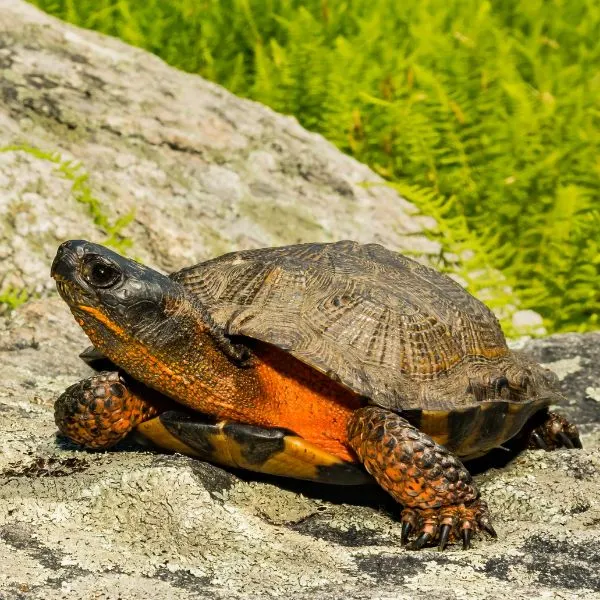
- Experience Level: *Expert
- Family: Emydidae
- Scientific Name: Glyptemys muhlenbergii
- Other Names: Muhlenberg’s turtle
- Adult Size: 3.5 to 5 inches (9 to 12.5 cm)
- Life Span: Up to 60 years in the wild
- Average Price Range: Illegal to own, Federally protected species
- Conservation Status: Endangered
Bog turtles are North America’s smallest turtle species, and the most imperiled of the Nation’s turtles. These turtles are facing unprecedented habitat loss and increased predation from raccoons, crows, and other animals. Pet trade poaching is another major factor as an entire population can be wiped out when these people find them.
As the name suggests, these turtles prefer bogs, marshes, swamps, and other slow-moving waters with abundant vegetation. They like to swim in shallow waters, bask in the sun on thick vegetation, or hide in the mud.
Bog turtles have dark colored shells that may have a keel (raised ridge) in the center, and some have a faint starburst pattern on the scutes. Their plastron (the bottom section of the shell) is pale yellow with a black border.
Their skin and scales are dark brown to black, but they have bright orange patches on their cheeks that may connect and form a ring around their heads. As you can imagine, these turtles are the epitome of cuteness and are very sought after pets.
Bog turtles feed on both protein sources and vegetation. They will eat seed pods, fruits, duckweed, insects, worms, leeches, small fish, and other tiny aquatic organisms.
Box Turtles in North Carolina
2. Eastern Box Turtle

- Experience Level: Beginner
- Family: Emydidae
- Scientific Name: Terrapene carolina carolina
- Other Names: Land Turtle
- Adult Size: 4 to 7 inches
- Life Span: 50 to 100 years
- Average Price Range: $260 – $360
- Conservation Status: Michigan, New Hampshire, Massachusetts, and Connecticut—list the animal as a species of special concern, and Maine lists the turtle as endangered.
The Eastern Box turtle is the state reptile of North Carolina. Another docile and beautiful turtle, it can be found all across the state.
They have beautiful orange, yellow, or reddish patterns across their dark shells and skin, and each turtle can look different. Their patterns on the shells can be as different as fingerprints on humans.
Eastern Box turtles are found in damp forests, marshy grasslands, and humid woodland regions. They need an area with soft ground or deep leaf litter and abundant humidity. They also need a source of water nearby.
These turtles are not aquatic, but they will soak in the water, burrow in rotting logs, or bury themselves under leaves and in the soft dirt to escape the heat of the day. Eastern Box turtles are often most active after rain showers.
As they are the State Reptile, it’s illegal to keep Eastern Box turtles as pets in North Carolina. You can often find them when hiking in the woods or they may even cross your yard if you live near a wooded area with a stream or pond.
Box turtles are able to enclose themselves inside their shell. This adaptation helps to protect them from predators, as most are not able to get through the hard shell.
Eastern Box turtles are omnivores. As they roam across the woodland floor they will feed on worms, insects, fruits, berries, plants, mushrooms, and occasionally carrion.
Chicken Turtles in North Carolina
3. Eastern Chicken Turtle

- Experience level: Beginner
- Family: Emydidae
- Scientific Name: Deirochelys reticularia
- Other Names: N/A
- Average Adult Size: 6 – 9 inches
- Life Span: 13 – 20 years
- Average Price Range: $150 – $300
- Conservation Status: Threatened
Eastern Chicken turtles are medium-sized turtles with long necks. They have egg shaped oval shells that have orange or yellow netting patterns. Their skin is dark green or brownish-green and striped, and they have a bright yellow plastron.
These turtles prefer shallow, still waters such as marshes, swamps, ponds, oxbow lakes, and drainage ditches. If the water they inhabit dries up they will either search for a new area or bury themselves in the moist ground.
Chicken turtles are so named because of the taste of their meat. That’s not coming from experience, it’s just what I’ve learned so don’t come after me. I’d rather just eat chicken…
These long-necked turtles are mostly carnivores. They will feed on dead fish, live fish, tadpoles, insects, crayfish, mollusks, and sometimes vegetation.
Cooters in North Carolina
4. Eastern River Cooter

- Experience Level: Beginner to Intermediate
- Family: Emydidae
- Scientific Name: Pseudemys concinna concinna
- Other Names: River Cooter
- Adult Size: Between 8 and 12 inches
- Life Span: Between 20 and 40 years
- Average Price Range: $20 to $50
- Conservation Status: Special concern
Eastern River Cooters are medium-large freshwater aquatic turtles. They have a slightly flared carapace that’s highly decorated with colors and patterns. On the outer or marginal scutes, you’ll see dark colored spots, surrounded by a green or yellowish “C.”
They have a yellow to red plastron with a midline pattern. The skin and scales of this turtle are dark olive, brown, or nearly black with yellow stripes.
You’ll find these turtles in rivers, streams, and other bodies of water with a decent current. Or maybe you won’t see them as they are rather reclusive. When no one is looking they will bask in the sun, but when they notice movement they retreat to the secluded water.
Here they can remain for a very long time. Not only can they hold their breath for a long time but they can also breathe through their butts. Yes, you heard that right, they can breathe underwater while getting an enema. Some turtles, the Eastern River Cooter included, have cloacal sacs that can extract oxygen from the water.
Moving on! These fascinating turtles are mostly herbivorous. It’s thought that 90 to 95% of their diet is from algae and other aquatic vegetation.
5. Florida Cooter

- Experience level: Beginner
- Family: Emydidae
- Scientific Name: Pseudemys floridana
- Other Names: N/A
- Average Adult Size: 9 – 13 inches
- Life Span: 20 – 40
- Average Price Range: Approximately $20 – $50
- Conservation Status: Least concern
To tell a Florida Cooter from our previous entry, you’ll have to look closely at their plastron. Florida Cooters do not have any type of pattern on the bottom. They have similar colored carapaces and extremities.
Another way to tell them apart is their environment. Florida Cooters prefer quiet waters compared to the choppy river rapids. Swamps, ponds, marshes, and other wetlands are where you’ll find these turtles.
They love to bask and will spend hours at a time enjoying the sun. They also need abundant vegetation and a soft, possibly sandy substrate.
Like the River Cooter, this species of turtle is mostly herbivorous and will graze algae and plants in their watery habitat.
6. Northern Red-bellied Cooter
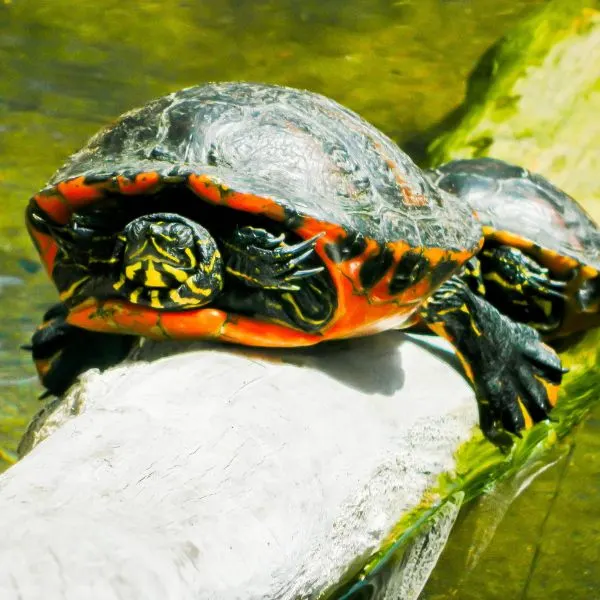
- Experience Level: Beginner to Intermediate
- Family: Emydidae
- Scientific Name: Pseudemys rubriventris
- Other Names: American red-bellied turtle
- Adult Size: Between 8 and 12 inches
- Life Span: Between 40 and 55 years
- Average Price Range: Between $30 and $170
- Conservation Status: Endangered
Northern Red-bellied Cooters are another shy, very cautious turtle. Again, they look quite similar to other cooter species except they have a bright red belly or plastron as their name suggests. They may also have red markings on their carapace, but they will fade and darken with age.
These turtles are found in ponds and rivers with soft bottoms and a lot of vegetation. They have also been known to reside in brackish waters as some have been found with barnacles adhered to their shells.
Northern Red-bellied Cooters are an endangered species, mostly because of habitat loss, and displacement by invasive Red Eared Sliders. These turtles also breed with Red-bellied Cooters which makes hybrids and puts more strain on the Cooters.
Like our other Cooter species, the Northern Red-belly consumes mostly vegetation. Young will occasionally feed on crayfish and other crustaceans, and insects.
Terrapins in North Carolina
7. Diamondback Terrapin

- Experience Level: Beginner to Intermediate
- Family: Emydidae
- Scientific Name: Malaclemys terrapin terrapin
- Other Names: Diamond-backed terrapin
- Adult Size: 4.5 to 9 inches (11.5 to 23 cm)
- Life Span: 25 to 40 years
- Average Price Range: $250 to $600
- Conservation Status: Special concern in North Carolina
Diamondback Terrapins are a beautiful species of turtle found in brackish waters and estuaries. These medium sized turtles are the only species that can and do live full time in saline water.
You’ll recognize these turtles by their diamond shaped carapace. Along with the shape you also notice the grey, brown, or nearly black shell with concentric black rings. Another striking appearance is the light colored to slate skin with black spots and speckles.
When they are swimming in the water, they like to stick their heads above the water like a snorkel.
Though they live in brackish water, these turtles still need to drink fresh water. How do they manage this? They will either come ashore during a rain shower and raise their open mouths to the sky and drink. They can also swim to the surface of the water where the freshwater hasn’t combined with the brackish water yet, and drink there.
Diamondback Terrapins are mostly carnivorous. They love to eat crabs and other crustaceans. This poses a big problem because they will crawl into crab traps to eat, and then get trapped themselves.
Crab fishermen are supposed to put terrapin escape hatches on their crab pots so these turtles are able to get free.
Mud Turtles in North Carolina
8. Eastern Mud Turtle

- Experience Level: Beginner
- Family: Kinosternidae
- Scientific Name: Kinosternon subrubrum
- Other Names: Common mud turtle
- Adult Size: 3 to 4 inches
- Life Span: 40 to 50 years
- Average Price Range: $20 – $100
- Conservation Status: Least concern
Eastern Mud turtles are small aquatic turtles that are found across the state except for the western mountainous region. They like to inhabit ponds, rivers, swamps, and the shallows of lakes.
They prefer a habitat with a muddy, soft substrate and abundant vegetation. Here they hunt amongst the reeds, leaves, and roots.
Eastern Mud turtles have significantly domed carapaces that are usually plain brown. Their skin is dark brown to black with lighter speckles, patches, and stripes.
Their plastron is hinged like box turtles and they can fully pull themselves inside to hide from predators. They can also release a pungent musk from glands located near their hind legs.
Keep that in mind if you get these turtles as pets. They also don’t like to be handled and will sometimes try to bite when they feel threatened.
Basking is a rare occurrence for Eastern Mud turtles. They prefer to stay hidden, and will sometimes burrow in the sand or mud either when it gets too hot, or during the cold winters.
Eastern Mud turtles are omnivores but they prefer meat over vegetables. They will feed on crayfish, leeches, tadpoles, fish, insects, mollusks, and other slow moving organisms.
9. Striped Mud Turtle
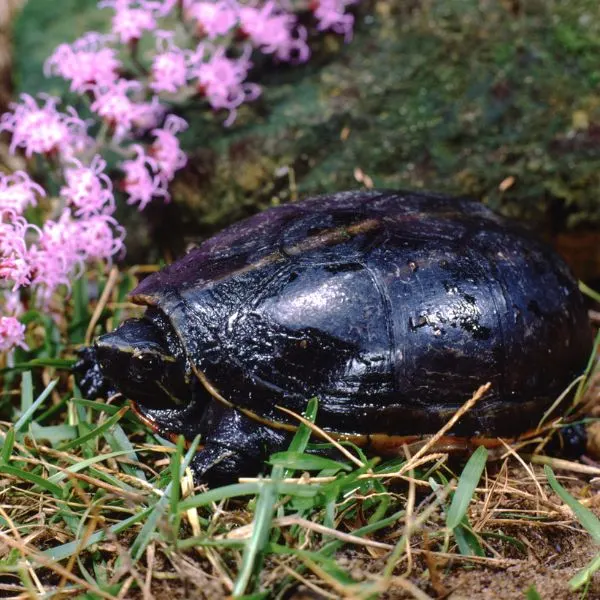
- Experience level: Beginner
- Family: Kinosternidae
- Scientific Name: Kinosternon baurii
- Other Names: 3-striped mud turtle, lined mud turtle
- Average Adult Size: 3 – 4 inches
- Life Span: 40 to 50 years
- Average Price Range: Approximately $100 – $160
- Conservation Status: Least concern
Striped Mud Turtles have a shell shape similar to other mud turtles, but they have three ridges running from front to back. These ridges are usually highlighted in white, but they tend to fade as the turtle ages.
Their skin is dark colored too and has several light colored stripes. The plastron is brown with dark borders around the scutes and double hinged. The growth plates form the letter “K” at the front and back of the turtle.
Striped Mud turtles prefer habitats with a lot of plant life, and shallow still waters. When they are not roaming the waters looking for food, they usually bury themselves in leaf litter. They have also been found rooting around in cow dung and eating the insects therein.
Nope, I have no comment here.
As you can probably tell, there isn’t much these turtles won’t eat. They are true omnivores that feed on insects, worms, fish, leeches, tadpoles, crustaceans, plants, and carrion.
Musk Turtles in North Carolina
10. Eastern Musk Turtle
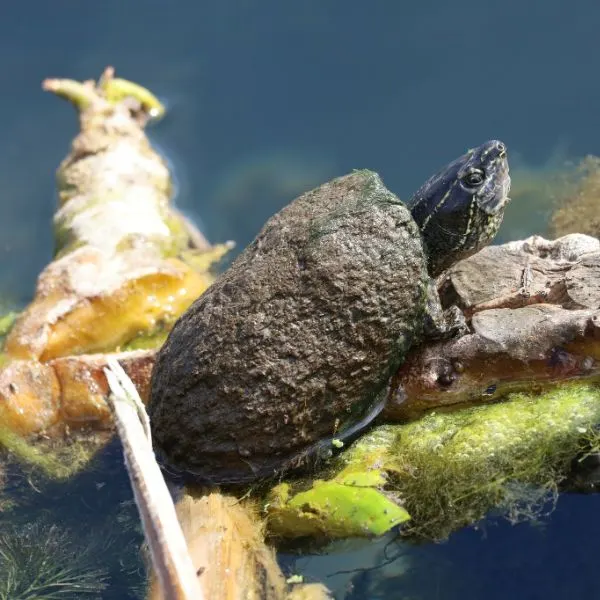
- Experience Level: Intermediate
- Family: Kinosternidae
- Scientific Name: Sternotherus odoratus
- Other Names: Common Musk turtle, Stinkpot
- Adult Size: 4 to 5 inches (10 to 12.5 cm)
- Life Span: 30 to 50 years
- Average Price Range: $30 to $120
- Conservation Status: Least concern
Eastern Musk turtles are small nocturnal turtles found all across North Carolina in slow-moving waters with dense aquatic vegetation and soft bottoms. Also called Common Musk turtles, they can release a potent odor from their musk glands when threatened, earning them the nickname of “Stinkpots”.
Another turtle with a domed shell and steep sides, they also have a somewhat flattened top. The color of the carapace can range from light brown to nearly black and has no discernable pattern.
These Musk turtles have a pointed head and a pair of white or yellow stripes that start at the snout and run above and below the eyes to the back of the head. They also have a hinged plastron, but they can’t pull themselves completely inside. The front hinge doesn’t close completely.
Eastern Musk turtles tend to walk along the bottom of the water and use plants to climb to the surface for air. They have gotten so good at climbing that they will climb trees. If the branches stretch down to the ground or linger in the water, these turtles will scale them.
Be careful of falling turtles! While in the trees they look for insects to eat. They are omnivores so they will eat small invertebrates and slow moving fish as well as plants.
11. Stripe-Necked Musk Turtle

- Experience level: Beginner
- Family: Kinosternidae
- Scientific Name: Sternotherus minor peltifer
- Other Names: Loggerhead Musk turtle, Stinkpot
- Average Adult Size: 3 – 5 inches
- Life Span: 30 to 50 years
- Average Price Range: $400 – $500
- Conservation Status: Threatened
Stripe-necked Musk turtles are aquatic and have larger heads than other types of Musk turtles. They have green shells and bold stripes running down their heads and necks. Hatchlings and juveniles have a keel in the middle of the carapace, but it tends to flatten out as they reach adulthood.
They are found in cool mountain streams and clear rivers with rocky bottoms. In North Carolina, they are only found in two extreme western counties close to Tennessee’s border.
Stripe-necked Musk turtles are a species of Special Concern in North Carolina and it’s illegal to keep them as a pet in the Tarheel State.
They are able to stay submerged in the water for a long time. They can absorb oxygen through their mouth and cheeks in a process called buccal pumping. They pump water in and out of their mouth and absorb oxygen directly into their bloodstream.
Stripe-necked Musk turtles are mostly carnivorous. Their main source of food is snails, but they will also eat insects and their larvae, worms, and vegetation.
Painted Turtles in North Carolina
12. Eastern Painted Turtle
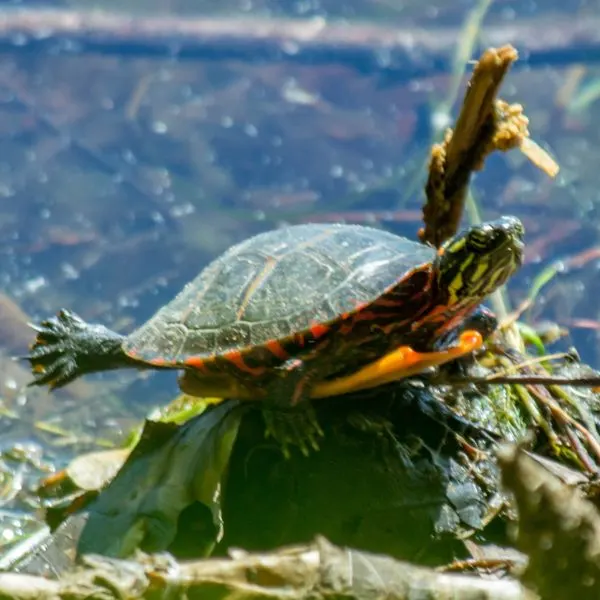
- Experience level: Beginner
- Family: Emydidae
- Scientific Name: Chrysemys picta
- Common Name: Painted Turtle
- Average Adult Size: 4 – 10 inches
- Life Span: 30 – 50 years
- Average Price Range: Between $30 to $150
- Conservation Status: Least Concern
There are a few subspecies of Painted turtles in the United States, and these turtles are the most common species found in the nation. Eastern Painted turtles are found throughout North Carolina, except for a few southern counties.
The Eastern Painted turtle has a smooth, dark carapace that has straight lines running both horizontally and vertically. The scutes align to make these patterns. Sometimes you may see them with flakes coming off their shells.
This isn’t a disease, it’s just how they shed part of the shells just like we shed skin and hair. Turtles can’t shed their entire shell, but some species lose sections of their scutes in flakes.
The undersides of the Eastern Painted turtle’s shell are orange or red with darker swirls or patterns. The plastron is tan to dingy yellow and solid colored.
The skin on these turtles is dark brown to black with abundant yellow stripes.
These turtles can eat both on land and in the water, but their diet hasn’t been extensively studied. They have been observed eating fish carrion, dragonfly larvae, and plant matter.
Pond Sliders in North Carolina
13. Red Eared Slider

- Experience level: Beginner
- Family: Emydidae
- Scientific Name: Trachemys scripta elegans
- Common Name: Pond slider, Red-eared terrapin, Water slider
- Average Adult Size: 6 – 8 inches
- Life Span: 20 to 40 years
- Average Price Range: approximately $30 to $100
- Conservation Status: Least concern
The Red Eared Slider’s native range extends beyond the central and southern states, but its range does not extend all the way into North Carolina. They have been found in the Tarheel State though and are considered an invasive species.
Like many other states, it’s illegal to own these turtles in North Carolina without a permit. That’s because when they are released into the wild, they become a nuisance and threaten native populations. Red Eared Sliders are listed as one of the 100 most invasive species in the world.
Red Eared Sliders are attractive turtles, especially when they are young. They have a green carapace with colorful patterns, dark skin, and bright yellow striping along the head, neck, and limbs. Behind their eyes are a pair of red patches that look like tympanic membranes (eardrums).
Most of these colors fade and darken as the turtle ages.
While these turtles prefer slow moving waters with abundant basking spots, they can establish colonies in most types of freshwater. When basking, these turtles will crowd out other species and often climb on top of each other.
Another attribute that makes these turtles so invasive is their ability to eat a wide variety of foods. They will eat vegetation, insects, fish, crayfish, worms, mollusks, and nearly anything else. If they were the size of an elephant, they would probably eat anything that moved…or didn’t.
14. Yellow Belly Slider
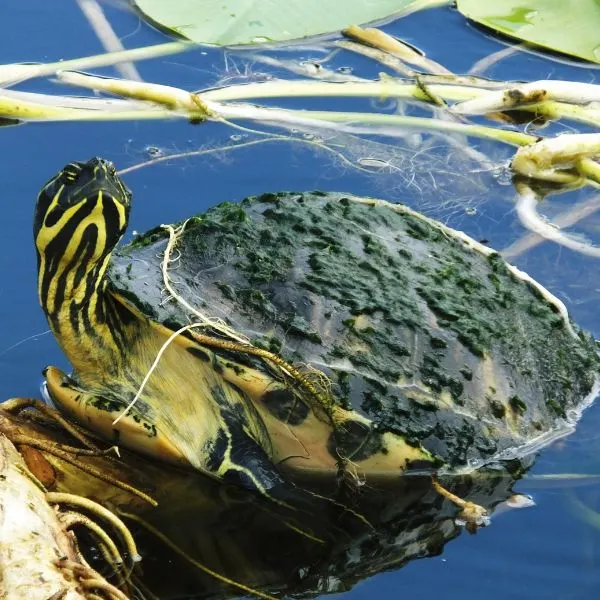
- Experience level: Beginner
- Family: Emydidae
- Scientific Name: Trachemys scripta scripta
- Other Names: Pond slider, Yellow slider
- Average Adult Size: 5 – 13 inches
- Life Span: 50 to 100 years
- Average Price Range: approximately $30 to $130
- Conservation Status: Least concern
Yellow Belly Sliders are popular pets, and one of the species that you can legally keep in North Carolina. They have a colorful carapace that is full of yellows, greens, browns and oranges. Their plastron is bright yellow and may have dark spots along the edge.
The skin on these turtles is dark green or brown with wide swaths of yellow. They are often confused with Red Eared Sliders, but their stripes are wider, they sometimes have a lazy “S” shape on the side of their heads, and they lack the red “ears.”
Wetlands such as swamps, marshes, rivers, and permanent ponds are where you’ll often find the Yellow Belly Slider. In North Carolina, they are mostly found in the eastern half of the state.
Males are much smaller than females in this species. The boys grow to a max length of 9 inches, while the females max out at around 13 to 14 inches of carapace length.
They typically eat in the mornings and then spend much of the latter part of the day basking in the sun or floating near the surface. They love to hang out in algae and vegetation covered areas where they can forage better.
Yellow Belly Sliders feed on insects, fish, mollusks, crayfish, and vegetation.
Snapping Turtles in North Carolina
15. Common Snapping Turtle

- Experience level: Intermediate to Expert
- Family: Chelydrida
- Scientific Name: Chelydra Serpentina
- Other Names: Snapping Turtle, Snapper, Eastern Snapping Turtle
- Average Adult Size: 8 to 20 inches
- Life Span: 30 – 50 years
- Average Price Range: Approximately $40 to $120
- Conservation Status: Least concern
Common Snapping turtles are a large, freshwater species that are found all across North Carolina in many types of water. They can even withstand time in brackish water, but have to return to freshwater.
Snapping turtles have solid colored carapaces with three ridges, though they can disappear completely on aged turtles. They have long tails with bony ridges like a certain dinosaur.
They stand on large, long limbs and have an equally long neck ending in a broad head, and hooked beak. Their bumpy skin can range from dirty yellow to dark brown.
These turtles don’t like to leave the water often and don’t bask much. Females will leave the water and can travel for miles while they search for a place to lay their eggs. While on land, Common Snapping turtles are downright mean.
They can strike much faster than you can pull away, and if they catch flesh, you’re in for a very painful experience, and probably a hospital visit.
In the water, Snapping turtles are docile and will run away from larger creatures. I’ve even heard of people accidentally stepping on them, and all the turtle did was move away. That’s not an experience I would like to try out, mind you.
Common Snapping turtles mainly feed on meat, but they aren’t very active hunters. If they could, they would stay buried in the mud and just order Uber eats when they get hungry.
Instead, they lash out at fish, amphibians, crustaceans, mollusks, insects, and other small aquatic animals. Even turtles and waterfowl are on the Snapper’s menu if they get close enough.
Softshell Turtles in North Carolina
16. Spiny Softshell Turtle

- Experience Level: Intermediate to Expert
- Family: Trionychidae
- Scientific Name: Apalone spinifera
- Other Names: N/A
- Adult Size: 5 to 9 ½ inches for males, 10 to 17 inches for females
- Life Span: Between 20 and 50 years
- Average Price Range: Between $20 and $120
- Conservation Status: Threatened in some areas
Spiny Softshell turtles have flexible, cartilaginous, flattened shells with spiny projections along the front rim. They are usually tan, olive, or dark brown with rings, spots, or other dark splotches on the carapace.
Older individuals are darker, and the patterns fade, especially in females. While we are talking about the ladies, let’s talk about their size (oh no, that’s taboo!) Female softshell turtles can grow twice the size of males. The boys are around 5 to 9 inches long, while females can get 10 to 17 inches, and sometimes bigger.
These turtles prefer waters with decent currents and sandy banks and bottoms. They like to hide in the sand where they can’t be seen and ambush prey. They also need the soft, sandy banks to bury their eggs.
Spiny Softshell turtles have long necks and extended, tubular snouts that help them reach the surface without coming out of their hiding spot.
They are great swimmers with wide, webbed front and back feet. On land, they are not only fast, but when cornered or handled, they get aggressive. Softshell turtles will lash out with their sharp claws, and bite with their hooked beaks.
These turtles are mostly carnivorous. They will eat fish, tadpoles, frogs, insects, mollusks, and more. Rarely, these turtles will gang up on larger prey and cut and bite it to pieces.
Spotted Turtles in North Carolina
17. Spotted Turtle

- Experience Level: Intermediate to Expert
- Family: Emydidae
- Scientific Name: Clemmys guttata
- Other Names: Polka-dot turtle, “Spotty”
- Adult Size: 4 to 5 inches
- Life Span: Males up to 65 years; females up to 110 years
- Average Price Range: $200 to $300
- Conservation Status: Endangered
The Spotted turtle is a small, endangered turtle that is illegal to own in North Carolina. They are found among bogs, swamps, and wetlands in the eastern area. Pollution, habitat loss, and pet trade poaching have taken its toll on their numbers.
They are popular in the pet trade because they are so small and very attractive turtles. Spotted turtles have dark brown to black shells with several bright yellow or white spots. The head, limbs, and other exposed areas are also black with yellow or white spots.
Some may have no spots, while others can have up to 100.
Spotted turtles are semi-aquatic and spend as much time on land as they do in the water. While on land or in the water they are either basking or searching for food. They are omnivorous but tend to eat a more carnivorous diet.
Insects, fish, crayfish, worms, snails, slugs, and vegetation can be consumed by these turtles.
Sea Turtles in North Carolina
There are also 5 species of Sea turtles that can be seen off the coastline of North Carolina. All of these species are endangered, and cannot be kept as pets anywhere in the United States. We’ll still take a look at each turtle with the aim of providing a field guide in case you’re lucky enough to spot one in the wild.
18. Green Sea Turtle

- Experience level: N/A, Illegal to own any sea turtle
- Family: Cheloniidae
- Scientific Name: Chelonia mydas
- Other Names: Green Sea Turtle
- Average Adult Size: 3 – 4 feet
- Life Span: 50 – 70 years
- Average Price Range: N/A
- Conservation Status: Endangered
Green Sea turtles can be seen along coral reefs, bays, and shallow waters. Here they feed on algae, seaweed, and sea grasses. This diet makes their fat and internal organs turn green, and that’s where they get their name.
If you have seen them, you may have wondered why they are called Green Sea turtles because they have more brown, white, black, and other colors than they do green.
All species of sea turtles are endangered, some more than others. One of the biggest threats to their survival is trawling nets and giant commercial long lines. Turtles often get caught in them and are unable to get to the surface for air.
19. Hawksbill Sea Turtle
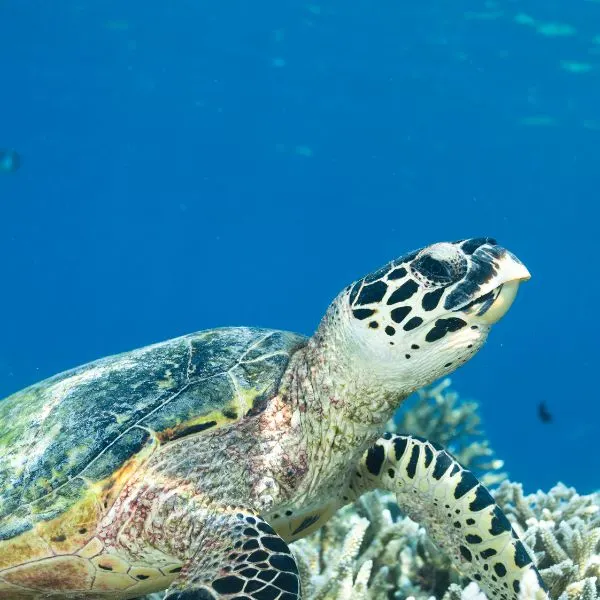
- Experience level: N/A, Illegal to own any sea turtle
- Family: Cheloniidae
- Scientific Name: Eretmochelys imbricata
- Other Names: Hawksbill
- Average Adult Size: 30 – 36 inches
- Life Span: 50 – 60 years
- Average Price Range: N/A
- Conservation Status: Critically endangered
Hawksbill Sea turtles have prominent beaks that are made for cutting through sea sponges, their favorite foods. These turtles are critically endangered, and only have an estimated 8,000 nesting females around the globe.
These turtles are often considered the most beautiful turtles in the world. They have large oval shells with gorgeous marbling patterns across the scutes. Unfortunately, it’s this beauty that harms them.
There are people out there who hunt the Hawksbill Sea turtle in order to harvest the shell. The carapace is then polished and made into lamps, hair accessories, jewelry, and other items.
Hawksbill Sea turtles travel across the tropical oceans, but mainly inhabit coastal reefs, rocky waters, and estuaries.
20. Kemp’s Ridley Sea Turtle

- Experience level: N/A, Illegal to own any sea turtle
- Family: Cheloniidae
- Scientific Name: Lepidochelys kempii
- Other Names: Atlantic Ridley, Tortuga Lora (Mexico)
- Average Adult Size: 24 – 27 inches
- Life Span: 30 years
- Average Price Range: N/A
- Conservation Status: Critically endangered
Not only are Kemp’s Ridley Sea turtles the most endangered Sea turtle species, but they are also the smallest. Coming in at a whopping 27 inches, even Alligator Snapping turtles can get bigger than these turtles.
These turtles have a serrated ridge along the middle of their shells. It’s usually greenish grey and flared at the edges. Their skin is cream colored to yellow.
Most of the time, these turtles stay in shallow waters and range from the North Atlantic to the Gulf of Mexico.
Kemp’s Ridley Sea turtles are omnivores that feed on fish, algae, jellyfish, crabs, and other crustaceans.
21. Leatherback Turtle
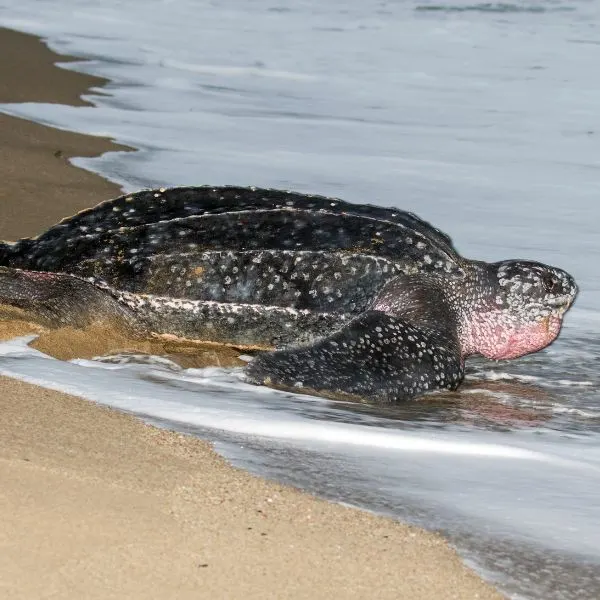
- Experience level: N/A, Illegal to own any sea turtle
- Family: Dermochelyidae
- Scientific Name: Dermochelys coriacea
- Other Names: Atlantic Leatherback, Leatherback
- Average Adult Size: 4 – 8 ft
- Life Span: 30 – 50 years
- Average Price Range: N/A
- Conservation Status: Endangered
Leatherback Sea turtles are the world’s heavyweight champion turtles. They grow up to 8 feet long, though some estimate they used to grow even larger, and can weigh up to 1,500 pounds.
How do they get so big? By eating a food that’s made up of 95% water and has no brain—jellyfish. They follow migrating hordes of lion’s mane jellyfish while munching on hundreds of them a day.
They can travel 10,000 miles a year in migrations from hunting grounds to mating and nesting sites. They can also dive farther than any other turtle, up to 4,000 feet deep. That’s just shy of a mile!
If you don’t recognize the Leatherback Sea turtle from its sheer size, then here are other physical attributes. They have a dark grey, nearly black upper half, and a much lighter bottom half. On their leathery backs, you’ll find 7 ridges that come to a point at the end, and you’ll see they have huge front flippers.
22. Loggerhead Sea Turtle

- Experience Level: N/A, Illegal to own any sea turtle
- Family: Cheloniidae
- Scientific Name: Caretta Caretta
- Other Names: Loggerhead
- Adult Size: 2.5 – 3.5 feet
- Life Span: 70 – 80 years
- Average Price Range: N/A
- Conservation Status: Endangered
Loggerhead Sea turtles are the most common Sea turtle species in the world, but they are still considered endangered. They are also the largest hard-shelled turtle in the world.
They have a somewhat heart-shaped reddish-brown carapace, flippers, and head. Their underside is light colored.
Their heads are very large and rounded relative to their size. They have broad, dull jaws that are used to crack very hard shells. These turtles eat conches, whelks, and other hard shelled creatures and have to have strong jaws to break through their defenses.
Loggerhead Sea turtles spend most of their lives in tropical or subtropical waters around the globe.
Wrapping up
So that wraps up our list of the turtles that you can find in North Carolina. We’ve looked at several freshwater turtles such as Spiny Softshell turtles, Common Musk turtles, and Spotted turtles, as well as 5 species of Sea turtles that can be spotted off the shores of North Carolina.
Turtles across the nation need our help. You can help by cleaning up after yourself while exploring nature, not disturbing wild turtles, and buying from reputable, licensed breeders when looking for a pet.
If you are unable to care for your turtle for any reason, don’t set it free in the wild. Look for an adoption agency, a rescue outfit, or consult your local vet. Releasing captive bred turtles into the wild can have a negative impact on native species.
If you enjoyed this list and are thinking about choosing one of these turtles as your next pet, don’t hesitate to comment down below!
Other nearby states
